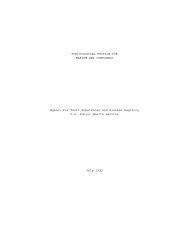Comparison of Disintegration Methods at a Full-scale ... - BVSDE
Comparison of Disintegration Methods at a Full-scale ... - BVSDE
Comparison of Disintegration Methods at a Full-scale ... - BVSDE
You also want an ePaper? Increase the reach of your titles
YUMPU automatically turns print PDFs into web optimized ePapers that Google loves.
degree <strong>of</strong> disintegr<strong>at</strong>ion DD COD [%]<br />
40<br />
35<br />
30<br />
25<br />
20<br />
15<br />
10<br />
5<br />
0<br />
(DD cod) oxid<strong>at</strong>ion with ozone, including energy for oxygene<br />
(DD cod) ultrasonic homogeniser<br />
(DD cod) lys<strong>at</strong>e centrifuge<br />
(DD o) disk mill sytem, bead diameter: 600-800 µm<br />
(DD o) disk mill system, bead diameter: 150-250 µm<br />
(DD o) annular chamber mill system<br />
0.0 0.5 1.0 1.5 2.0 2.5 3.0 3.5 4.0<br />
specific energy [kWh/kg TS]<br />
Figure 1 <strong>Comparison</strong> <strong>of</strong> different disintegr<strong>at</strong>ion methods by energy consumption<br />
The annular chamber mill reaches a medium degree <strong>of</strong> disintegr<strong>at</strong>ion <strong>at</strong> a rel<strong>at</strong>ively low energy<br />
demand. The disk mill uses a higher energy input, due to th<strong>at</strong>, a higher degree <strong>of</strong> disintegr<strong>at</strong>ion can<br />
be achieved. Using grinding beads with smaller diameters improves efficiency. With chemical<br />
oxid<strong>at</strong>ion a high degree <strong>of</strong> disintegr<strong>at</strong>ion can be achieved, but additional energy for the production<br />
<strong>of</strong> pure oxygen, necessary for gener<strong>at</strong>ing the ozone, is needed. This has already been considered in<br />
the figure above. Energy input <strong>of</strong> an ultrasonic homogeniser is less effective than the other<br />
aggreg<strong>at</strong>es. With lys<strong>at</strong>e centrifugal technique an average degree <strong>of</strong> disintegr<strong>at</strong>ion <strong>of</strong> 10 % DDCOD<br />
could be achieved. During long-term investig<strong>at</strong>ions with the stirred ball mills an average degree <strong>of</strong><br />
disintegr<strong>at</strong>ion <strong>of</strong> about 25 % DDO (annular chamber mill) and 60 % DDO (disk mill) was obtained.<br />
Tre<strong>at</strong>ment with ozone resulted in 30 % DDCOD mean value. Mean value 17 % DDCOD was achieved<br />
with the ultrasonic homogeniser.<br />
Oper<strong>at</strong>ional behaviour<br />
Clogging by coarse or fibrous particles was not a problem for any <strong>of</strong> the aggreg<strong>at</strong>es. A mechanical<br />
pre-tre<strong>at</strong>ment was not necessary. No abnormal wear <strong>at</strong> the aggreg<strong>at</strong>es was observed. Only a high<br />
loss <strong>of</strong> grinding beads because <strong>of</strong> wear (disk mill) and the sudden shutdown <strong>of</strong> the mill (annular<br />
chamber mill) occurred. The ozone plant was more difficult to handle because <strong>of</strong> foaming problems<br />
and had several breakdowns. The ultrasonic homogeniser had <strong>at</strong> first problems with he<strong>at</strong>. The<br />
sludge flow was not high enough for cooling the sonotrodes. This resulted in several break downs<br />
<strong>of</strong> the sonotrodes. Since an extern cooling system was installed no further problems occurred.<br />
Anaerobic tre<strong>at</strong>ment<br />
When applying the different disintegr<strong>at</strong>ion aggreg<strong>at</strong>es, an increase <strong>of</strong> the anaerobic biodegradability<br />
could be observed in all cases. This effect varied depending on the degree <strong>of</strong> disintegr<strong>at</strong>ion. The<br />
following table shows the degree <strong>of</strong> degrad<strong>at</strong>ion <strong>of</strong> both digesters, one fed with disintegr<strong>at</strong>ed excess<br />
sludge and one fed with untre<strong>at</strong>ed sludge.<br />
An evident increase <strong>of</strong> the degree <strong>of</strong> degrad<strong>at</strong>ion could be achieved using a stirred ball mill and<br />
chemical disintegr<strong>at</strong>ion with ozone. A lesser effect was observed with lys<strong>at</strong>e centrifuge and<br />
100<br />
75<br />
50<br />
25<br />
0<br />
degree <strong>of</strong> disintegr<strong>at</strong>ion DD O [%]<br />
575
















